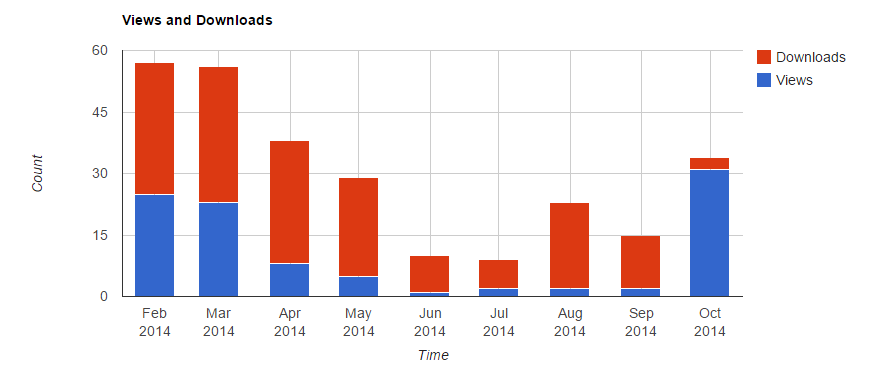A selection of the open educational resources that have been released from the School of Science and Technology at the University of Northampton.
This post shows the number of views and downloads of these resources by the end of November 2014. Warning there may be some errors in the October data due to a change in the Jorum system:
"Following our recent upgrade to significantly improve performance and stability, we realised that there is now a difference in the way resource views are recorded. These will be artificially inflated for October only, and we are working on a fix; the stats will be post-processed at that point, so they accurately reflect real usage" http://find.jorum.ac.uk/resources/18529/report
This post shows the number of views and downloads of these resources by the end of November 2014. Warning there may be some errors in the October data due to a change in the Jorum system:
"Following our recent upgrade to significantly improve performance and stability, we realised that there is now a difference in the way resource views are recorded. These will be artificially inflated for October only, and we are working on a fix; the stats will be post-processed at that point, so they accurately reflect real usage" http://find.jorum.ac.uk/resources/18529/report
Pollution And Pollutants
Authors: Paul Cox and Nigel Freestone
Details

Pollution is the undesirable introduction of pollutants (contaminants) into the natural environment (land, air and water) and can have an adverse affect on human health. This resource provides an introduction to pollution and pollutants. The classification and distribution of pollutants is also considered. A number of self-assessment questions are provided to allow you to check your new knowledge. The material comes in Word format and its HTML equivalent. The pollutants.htm file includes two images (poll.gif and ld50.gif) and an answers page (SAQ_Answers.htm) related to it that need to be put in the same folder as the pollutants.htm file.
Keywords:
The resource found on Jorum at: http://find.jorum.ac.uk/resources/18529
Properties of Ultrasonic Waves
This material gives the description of the physical processes involved in the propagation of ultrasonic pressure waves as they pass through a material. It includes a mathematical derivation of the amplitude of the transmitted and reflected pressure waves, and an explanation is given for the differences between the near and far zones. This material has been used in the Advanced Inspection Methods and Techniques module as part of the BSc programme in Non-Destructive Testing at the University of Northampton.
Published: School of Science and Technology, University of Northampton
Keywords:
Summary of Evolutionary Algorithms
 Click here for the resource: http://find.jorum.ac.uk/resources/19204
Click here for the resource: http://find.jorum.ac.uk/resources/19204
These slides are intended for undergraduate computing students, providing an overview of Genetic Algorithms, a concept of in artificial intelligence. As well providing an overview the material also include links to applications via web resources. The slides are taken from an undergraduate artificial intelligence module on the BSc Computing Programme at the University of Northampton. Possible uses of these including support material for second year, third year or masters level course on artificial intelligence.
Click here for the resource: http://find.jorum.ac.uk/resources/19204
C Programming
Click here for the resource: http://find.jorum.ac.uk/resources/19192
Click here for the resource: http://find.jorum.ac.uk/resources/19192
Problem-Solving
Author: Dr Scott Turner
These mini lectures are intended for undergraduate computing students, for providing simple steps in problem solving before the students learn a programming language. Problem-Solving and Programming is a common first year undergraduate module on the BSc Computing Programme at the University of Northampton. This material was taken from the problem solving part of the module and provides an introduction to five topics in problem-solving.
The resource can be found at: http://find.jorum.ac.uk/resources/19001
Sustainability: Environmental Business Imperatives
 This video outlines the drivers for resource efficiency for business including raw materials scarcity and economic imperatives. The savings that can be made by more efficient use of raw materials, energy and waste are highlighted. Case study examples are given to show how different sectors have achieved resource efficiency and moved towards a circular model of resource use.
This video outlines the drivers for resource efficiency for business including raw materials scarcity and economic imperatives. The savings that can be made by more efficient use of raw materials, energy and waste are highlighted. Case study examples are given to show how different sectors have achieved resource efficiency and moved towards a circular model of resource use.
 This video outlines the drivers for resource efficiency for business including raw materials scarcity and economic imperatives. The savings that can be made by more efficient use of raw materials, energy and waste are highlighted. Case study examples are given to show how different sectors have achieved resource efficiency and moved towards a circular model of resource use.
This video outlines the drivers for resource efficiency for business including raw materials scarcity and economic imperatives. The savings that can be made by more efficient use of raw materials, energy and waste are highlighted. Case study examples are given to show how different sectors have achieved resource efficiency and moved towards a circular model of resource use.All views are the authors, and may not reflect the views of any organisation the author is connected with in any way..






